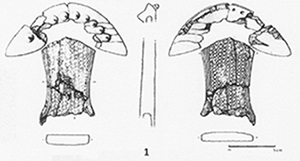Crossref Citations
This article has been cited by the following publications. This list is generated based on data provided by
Crossref.
Dolfini, Andrea
2020.
From the Neolithic to the Bronze Age in Central Italy: Settlement, Burial, and Social Change at the Dawn of Metal Production.
Journal of Archaeological Research,
Vol. 28,
Issue. 4,
p.
503.
Lillios, Katina T.
2020.
Mobility and Alterity in Iberian Late Prehistoric Archaeology: Current Research on the Neolithic–Early Bronze Age (6000–1500 BCE).
Annual Review of Anthropology,
Vol. 49,
Issue. 1,
p.
49.
Derenne, Eve
Ard, Vincent
and
Besse, Marie
2020.
Pottery technology as a revealer of cultural and symbolic shifts: Funerary and ritual practices in the Sion ‘Petit-Chasseur’ megalithic necropolis (3100–1600 BC, Western Switzerland).
Journal of Anthropological Archaeology,
Vol. 58,
Issue. ,
p.
101170.
Derenne, Eve
Ard, Vincent
and
Besse, Marie
2022.
Potters’ Mobility Contributed to the Emergence of the Bell Beaker Phenomenon in Third Millennium BCE Alpine Switzerland: A Diachronic Technology Study of Domestic and Funerary Traditions.
Open Archaeology,
Vol. 8,
Issue. 1,
p.
925.
Ramírez-Cruzado Aguilar-Galindo, Samuel
Muñiz Guinea, Fernando
Ruiz Muñoz, Francisco
González-Regalado, Maria Luz
Vargas Jímenez, Juan Manuel
Díaz-Guardamino, Marta
García Sanjuán, Leonardo
Donaire Romero, Teodosio
Rodríguez-Vidal, Joaquin
and
Cáceres Puro, Luis Miguel
2023.
Gastrochaenolites as Palaeoenvironmental Information Traps: The Case of the Tholos of La Pastora (Valencina de la Concepción, SW Spain).
Environmental Archaeology,
p.
1.
Bilotti, Giacomo
Kempf, Michael
and
Morillo Leon, Jose Miguel
2024.
Modelling land and water based movement corridors in the Western Mediterranean: a least cost path analysis from chalcolithic and early bronze age ivory records.
Archaeological and Anthropological Sciences,
Vol. 16,
Issue. 8,
García Sanjuán, Leonardo
Montero Artús, Raquel
Emslie, Steven D.
Lozano Rodríguez, José Antonio
and
Luciañez-Triviño, Miriam
2024.
Beautiful, Magic, Lethal: a Social Perspective of Cinnabar Use and Mercury Exposure at the Valencina Copper Age Mega-site (Spain).
Journal of Archaeological Method and Theory,
Vol. 31,
Issue. 3,
p.
1006.
Sanjuán, Leonardo García
Ramírez-Cruzado, Samuel
Díaz-Guardamino, Marta
Rodríguez, José Antonio Lozano
Romero, Teodosio Donaire
Vargas, José Ángel Afonso
Rodríguez-Rellán, Carlos
Nieto, Verónica Balsera
Cáceres Puro, Luis M.
Wheatley, David W.
Earle, Timothy
Cintas-Peña, Marta
Jiménez, Juan Manuel Vargas
Flores, Álvaro Fernández
Triviño, Miriam Luciañez
Cárdenas-Párraga, Juan
Merino, María Martínez
and
Guinea, Fernando Muñiz
2025.
A multi-analytical study of the Montelirio beaded attires: Marine resources, sumptuary crafts, and female power in copper age Iberia.
Science Advances,
Vol. 11,
Issue. 5,



